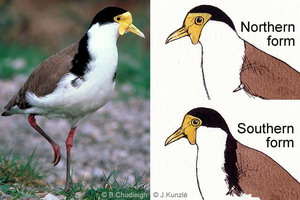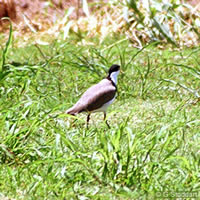Cook Islands Natural Heritage Articles
Masked Lapwing - A Very Rare Visitor
During November and December several people reported an unusual bird on Rarotonga and Aitutaki. What was it, and did it come from Alaska?
Migrants and vagrants
A migrant bird is one that visits each year for a season. The Pacific Golden-Plover (Tōrea) is a migrant that arrives here each year during October and November from Alaska. During our summer it is common on grassed areas and on the shore. It is a brown bird with black speckles.
A vagrant bird is one that visits once, or a few times at irregular intervals. The American Laughing Gull is a vagrant that has been reported several times in the Cook Islands over the last 15 years, and the Great Crested-Tern has been reported a few times.
Masked Lapwing
 The first Masked Lapwing was recorded on the Rarotonga Airport in October 1993 by the author. No more were reported for nine years.
The first Masked Lapwing was recorded on the Rarotonga Airport in October 1993 by the author. No more were reported for nine years.
On 12th October 2002 Gary Tuttle and Ruth Vomund recorded a Masked Lapwing on the Aitutaki golf course, and on the 20th one was recorded, independently by Eddie Saul and Malcolm Turner, on the field west of Nikao Beach Video. This bird was photographed by Geoff Stoddard in late December. With no reports of the lapwing on Aitutaki after the 12th we cannot determine if the bird on Rarotonga was the same bird or a different one, and Rarotonga bird seems to have left early January.
The Masked Lapwing is very widespread in Australia, where it has two distinct forms or races. The northern race has white shoulders and nape of neck. It is found throughout northern Australia and has recently extended its range by colonizing southern New Guinea.
The southern race has black shoulders and nape of neck. It is found in southern Queensland, southeast Australia, and Tasmania. It is also called the eastern race.
In 1932 two birds of the southern form reached New Zealand and breed at Invercargill airport. Twenty years later there were a hundred birds within 20 kilometres of the airport. By 1965 they had spread throughout much of the South Island, and were on Steward Island. In 1973 a few breed in the southern part of the North Island. Twenty years later they were throughout the North Island, and in 1993 established themselves on the Kermadec Islands. In New Zealand they are known as Spur-winged Plovers, because of the claw or spur protruding from the mid-joint of the wing.
All the lapwings recorded in the Cook Islands have been black-shouldered Southern Masked Lapwings. The only other Pacific island-state with lapwing records is Fiji with one in 1997 and one in 1999 - one was the black-shouldered southern form and the other was not determined. Although speculative, we would suspect that the Cook Islands two or three lapwings are vagrants from North Island or the Kermadec Islands rather than from eastern Australia.
 The Southern Masked Lapwing (Vanellus miles novaehollandiae) is considerably larger than the common Pacific Golden-Plover, about 37cm total body length compared to 26cm. It has a large bright yellow wattle in front of each eye covering the forehead and hanging below the yellow bill. The underside of the bird is white. The head, back-of-neck, and shoulders are black. The back and folded wings are dark grey. In flight the black of the outer and hind wings is conspicuous along with the black tail tip.
The Southern Masked Lapwing (Vanellus miles novaehollandiae) is considerably larger than the common Pacific Golden-Plover, about 37cm total body length compared to 26cm. It has a large bright yellow wattle in front of each eye covering the forehead and hanging below the yellow bill. The underside of the bird is white. The head, back-of-neck, and shoulders are black. The back and folded wings are dark grey. In flight the black of the outer and hind wings is conspicuous along with the black tail tip.
It has a strong, slow-flapping flight. It has a loud staccato “keer-ki-ki-ki-ki” or ‘krik-krik-krik” call. It prefers open and grassy wetlands.
Images: B.Chudleigh, J.Kunzle, and G.Stoddart
First published in the Cook Islands News, 8 March 2003.
About Gerald McCormack
 Gerald McCormack has worked for the Cook Islands Government since 1980. In 1990 he became the director and researcher for the Cook Islands Natural Heritage Project - a Trust since 1999.
He is the lead developer of the Biodiversity Database, which is based on information from local and overseas experts, fieldwork and library research. He is an accomplished photographer.
Gerald McCormack has worked for the Cook Islands Government since 1980. In 1990 he became the director and researcher for the Cook Islands Natural Heritage Project - a Trust since 1999.
He is the lead developer of the Biodiversity Database, which is based on information from local and overseas experts, fieldwork and library research. He is an accomplished photographer.
Citation Information
McCormack, Gerald (2005) Masked Lapwing - A Very Rare Visitor. Cook Islands Natural Heritage Trust, Rarotonga. Online at http://cookislands.bishopmuseum.org. ![]()
Please refer to our use policy
